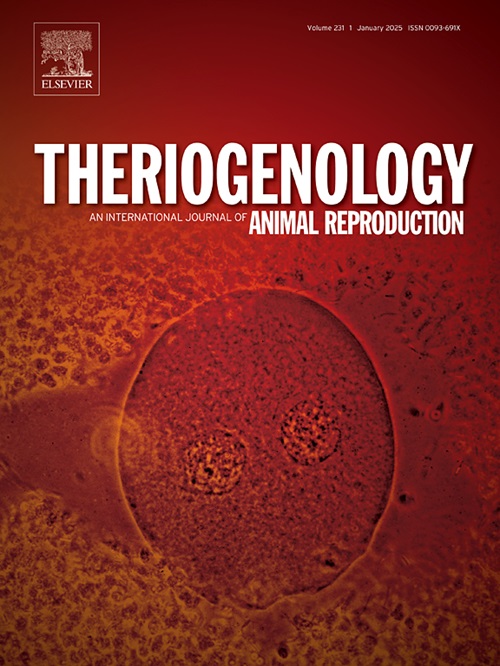Biostimulation with rams improved embryo quality without modifying the ovulatory response in superovulated ewes
IF 2.4
2区 农林科学
Q3 REPRODUCTIVE BIOLOGY
引用次数: 0
Abstract
The aim of this study was to evaluate whether extended ram exposure during FSH superovulatory treatment improves follicular growth, embryo production, and embryo quality in ewes. Twenty Santa Inês ewes were subjected to a superovulation protocol based on follicle-stimulating hormone (FSH) administration with or without male biostimulation in a crossover arrangement (n = 20 per treatment). Follicular development and corpus luteum functionality were monitored with ultrasound, and embryo collection was performed non-surgically. Recovered embryos were analyzed for gene expression, reactive oxygen species (ROS) levels, and blastomere count. Male biostimulation for 72 h did not modify the number or diameter of antral follicles, the recovery rate of structures, reactive oxygen species (ROS) levels, and blastomere count. However, it reduced the expression of genes linked to oxidative stress (PRDX1) and apoptosis (BCL2) in embryos. In summary, exposure to rams for 72 h during superovulatory treatment influenced molecular indicators of development competence, specifically the relative abundance of BCL2 and PRDX1 transcripts, which are associated with cellular apoptosis and stress. However, it did not improve the ovarian responses.
公羊生物刺激提高了胚胎质量,但不改变超排卵母羊的排卵反应
本研究的目的是评估在卵泡刺激素超排卵治疗期间延长公羊暴露时间是否能改善母羊的卵泡生长、胚胎产量和胚胎质量。20只Santa Inês母羊接受了基于促卵泡激素(FSH)管理的超排卵方案,在交叉安排中有或没有雄性生物刺激(每次治疗n = 20)。超声监测卵泡发育和黄体功能,非手术采集胚胎。对恢复的胚胎进行基因表达、活性氧(ROS)水平和卵裂球计数分析。雄性生物刺激72 h对卵泡数量和直径、结构恢复率、活性氧(ROS)水平和卵裂球计数没有影响。然而,它降低了胚胎中与氧化应激(PRDX1)和凋亡(BCL2)相关的基因的表达。综上所述,在超排卵处理期间,公羊暴露72小时会影响发育能力的分子指标,特别是与细胞凋亡和应激相关的BCL2和PRDX1转录物的相对丰度。然而,它并没有改善卵巢反应。
本文章由计算机程序翻译,如有差异,请以英文原文为准。
求助全文
约1分钟内获得全文
求助全文
来源期刊

Theriogenology
农林科学-生殖生物学
CiteScore
5.50
自引率
14.30%
发文量
387
审稿时长
72 days
期刊介绍:
Theriogenology provides an international forum for researchers, clinicians, and industry professionals in animal reproductive biology. This acclaimed journal publishes articles on a wide range of topics in reproductive and developmental biology, of domestic mammal, avian, and aquatic species as well as wild species which are the object of veterinary care in research or conservation programs.
 求助内容:
求助内容: 应助结果提醒方式:
应助结果提醒方式:


